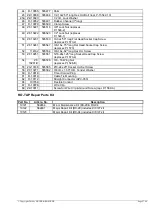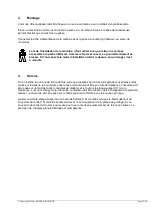
© Copyright 2010 by HAVER & BOECKER
Page 24/44
11.
Operation time of sieve analysis
The necessary time for performing a sieve analysis with the RO-TAP depends on the kind of sieve
analysis. In most cases, for example for a normal product control, three to five minutes are enough to
receive the required data. Materials that are difficult to sieve may require sieve times of about 10 to 30
minutes.
When performing sieve analyses to check, whether the analysed product corresponds to a certain
specification or not, longer sieving times may be necessary. Everybody concerned about should agree to
the same procedure in order to receive comparable and reproducible results.
To determine the sieving time it is recommended to take three or four samples from a sample splitter with
a feeding quantity that has been proved before. One of these samples should be sieved for five minutes,
another for ten minutes, another for 15 minutes and a fourth one for 20 minutes. After the results have
been fixed in a table, the best sieving time for uniform results shall be visible. If the result of the following
sieving period does not differ more than 0.5 % to 1 % the sieving is finished.
12.
Weighing the sieve residue
After the test sieving is finished, the whole test sieve set should be weighed by the scale to survey the
data. Weighing should always be in gram with a scale with a measuring range of at least 500 gram. A
sensibility of 0.1 gram is recommended.
If there are several sieve pans the residues should not been thrown away as long as the weighing has not
been finished. The same procedure should be done with the test sieves in the sieve set. The sieving
material retained in the sieve pan by the finest test sieve bottom has to be weighed, too, in order to
receive the total weight and the proportionate in percent. The sum of the different fractions is compared
to the feeding weight. The total sum of the sieving material retained on the different sieve bottoms
(residue) and the residue in the sieve pan should correspond to the feeding quantity.
When using a further sieve pan (collector) to weigh the residues the material remained on the coarsest
test sieve should be given first into the pan. With a smooth brass or nylon brush the downside of the
sieve bottom is then brushed carefully by circular motion, without damaging the wire cloth.
In almost every cases the cut-point-close particles blocked in the meshes, can be moved out of the sieve
by this dry brushing method. The test sieve border then can be tapped carefully by the brush stick to
loosen last remaining particles.
Содержание TYLER Ro-Tap RX-29
Страница 14: ...Copyright 2010 by HAVER BOECKER Page 14 44 Bild 1 1...
Страница 15: ...Copyright 2010 by HAVER BOECKER Page 15 44 Bild 2 1...
Страница 28: ...Copyright 2010 by HAVER BOECKER Page 28 44 picture 1 1...
Страница 29: ...Copyright 2010 by HAVER BOECKER Page 29 44 picture 2 1...
Страница 43: ...Copyright 2010 by HAVER BOECKER Page 43 44 Fig 1 1...
Страница 44: ...Copyright 2010 by HAVER BOECKER Page 44 44 Fig 2 1...






























